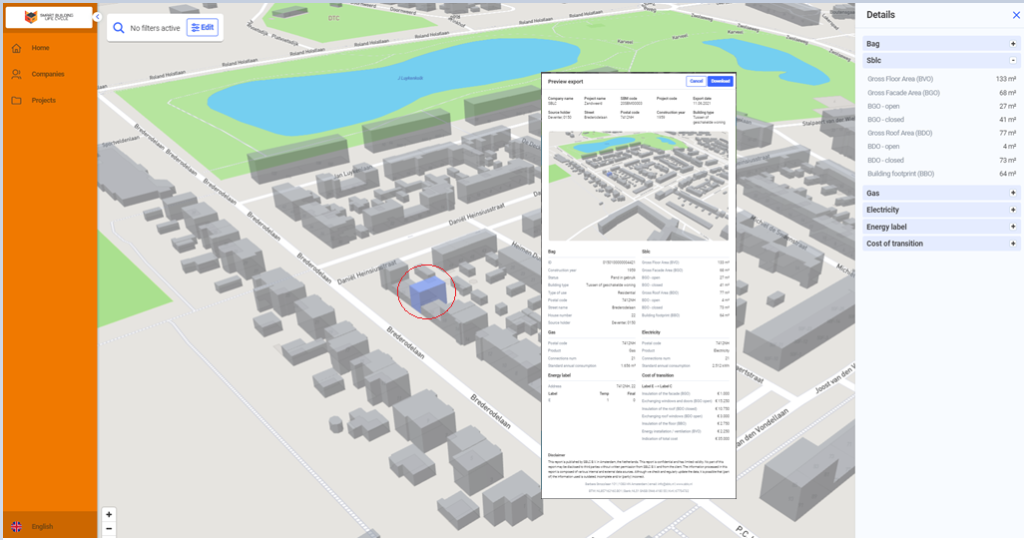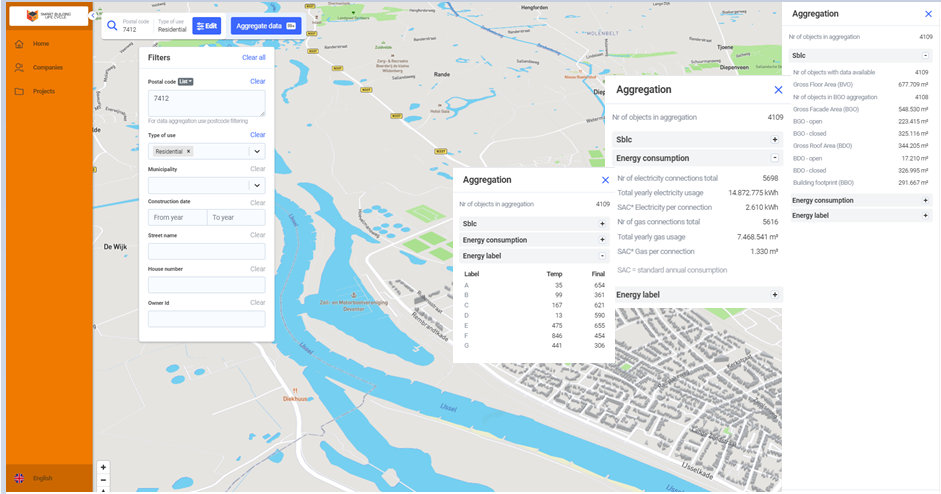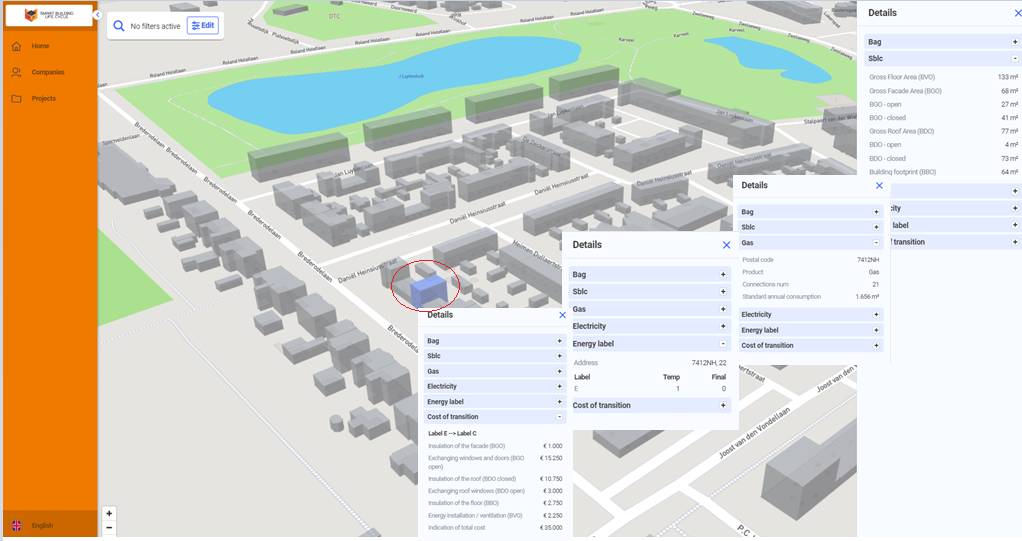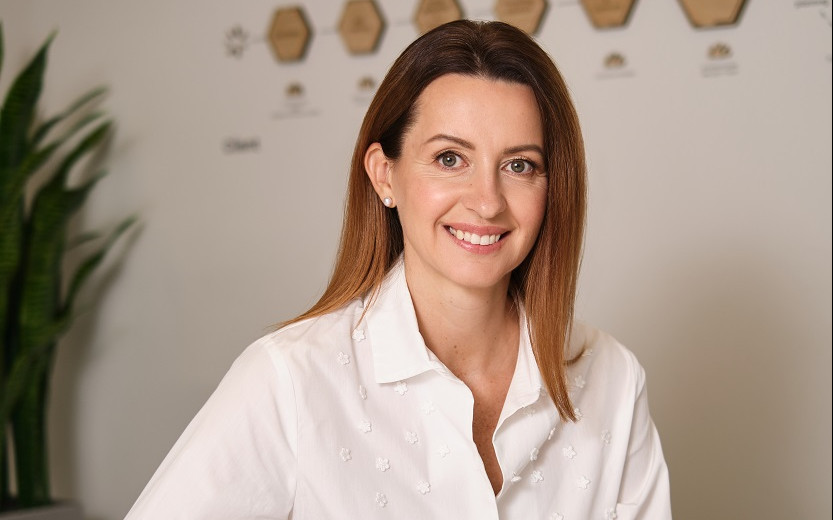What’s our process for executing an MVP for a startup customer? How can you benefit from open data as a company, and how can digital twin applications facilitate green transition?
Read how Helmes helped a Dutch startup implement its vision for an app for analyzing and improving the energy performance of any building in the country based on publicly available data and its proprietary know-how.
Overview: A green tech startup in need of a proof-of-concept
Like in many countries, the green transition has been hailed as a priority in the Netherlands, and the government has set ambitious energy-saving and CO2-reduction targets by 2030. However, SBLC, a young technical services company, noticed a critical piece missing in the puzzle.
The team envisioned a web app that would map any building in the country, provide insights into what is needed to reduce its energy consumption, and outline the associated costs. The app selects, combines, and shows the relevant data from many available sources and adds unavailable data and unique algorithms to calculate the expected transition costs. It envisioned a simple yet powerful tool that would simplify informed choices by municipalities, urban planners and consultants, commercial real estate, and homeowners.
The challenge: to turn data and expertise into actionable insights
Our task as SBLC’s development partner was two-fold. First, import all relevant publicly accessible data on buildings and their energy consumption onto an easy-to-use platform. Second, to translate the firm’s proprietary expertise in the energy performance field into formulas that would enable the app to provide an overview of the current situation and suggestions and calculations for improving energy efficiency.
We needed to deliver the results fast so that the customer could move into an active sales phase and validate their concept in pilot projects (in the end, the actual development phase was completed in two months).
The result: a digital twin app covering every building in the Netherlands
The outcome, Smart Building Monitor, is currently live with its first customers. The web-based map application allows licensed users to access the following information on all buildings in the Netherlands:
- Building details, for example, construction year, status (in use or not), type (residential or commercial), purpose (office, store, sports, etc.), address, postal code, and municipality.
- Calculations based on building details, for example, gross floor and facade area, gross closed area.
- Energy consumption and energy label. The data for gas and electricity consumption is derived from various energy service providers and anonymized under data protection regulations.
- Energy consumption can be identified on a postal code level (one postal code typically includes 10-20 buildings). The energy label can be identified at an apartment level (In the Netherlands, apartments in the same building can have different energy labels).
- Calculations of energy efficiency improvement costs based on data and proprietary formulas. For example, you can see how much it will cost to upgrade a building or a set of buildings from energy efficiency label G to label C.
The users can:
- Search for a specific building/address
- filter buildings (for example, according to a district, construction year, type of building, etc.)
- aggregate the data of filtered datasets
- save and export results



For example, as a real estate owner, you could filter out all buildings in your portfolio and compare the cost of energy improvements of different buildings. As a municipality, you could analyze the energy efficiency of buildings constructed in different periods and prioritize renovation tasks accordingly.
An essential factor in making technical choices was cost optimization, which is essential for any company, especially for a startup customer.
The app uses .NET for the back-end and React for the front-end, Mapbox for the map, PostgreSQL + PostGIS for the database, and DigitalOcean for cloud services.
Our approach: an hour of careful planning saves 10 hours of work
Our collaboration with SBLC broadly falls into three phases: a preliminary analysis, actual development, and a follow-up/iteration stage.
In the analysis phase, we gathered all stakeholders in Estonia for a two-day workshop where we mapped business needs, defined existing and missing data, outlined the first architectural solution, and validated it (not forgetting some fun and socializing, either). A joint team of 10 people included an analyst, back-end developer, front-end developer, architect, team leader, and business leaders from Helmes and the key business and technical people from SBLC. They added their years of expertise in real estate and construction cost management, automation, and planning. Read more about SBLC here: https://sblc.nl/en/
Such Quick Start meetings are, in fact, a regular part of our development process. We find them incredibly helpful for defining the preliminary scope of the project and ensuring resource and cost optimization. Read more: https://www.helmes.com/quick-start/
The active development phase involved constant communication in various formats, such as:
- Monthly meetings where we set objectives for the next month and allocate resources.
- Weekly meetings where we discussed use cases, functionalities, and development tasks with all core team members.
- A daily discussion on ongoing issues via Skype and Microsoft Teams between our analyst and the client’s representative.
After completing the initial development phase, we signed a contract for a follow-up project. We continued improving the product by adding new datasets and functionalities based on feedback from the users.
Read more on what it’s like to work with Helmes: Onboarding: The Secret of Successful Software Development Outsourcing
Collaboration in the times of COVID-19
As the active development phase took place in autumn 2020, when both Estonia and the Netherlands were in lockdown due to COVID-19, it was common for both our teams to be scattered around a dozen homes during our meetings. Although we believe planning is key to success at all times, working in such a remote setting necessitated preparing the meetings even more thoroughly than usual. For example, we drew up visual aids in advance and constantly doublechecking each other’s viewpoints to ensure everyone was on the same page. Though some of the team members have returned to the office by now (we believe in hybrid work in Helmes where everyone can choose their work setting), the experience armed us with plenty of valuable tips and tricks for successful remote collaboration in the future.
Are you looking for a custom software development partner for your business idea?
Whether you are planning to enter the market with a new innovative product or are looking for a software development partner for your existing services, we’d love to hear from you.
Helmes has been developing custom software for customers all over Europe for more than 30 years. Our clients include fast-growing startups, multinational companies in the telecom, fintech, logistics, healthcare, and other sectors and public institutions.
Check out our services or drop us a line.
Get in touch


